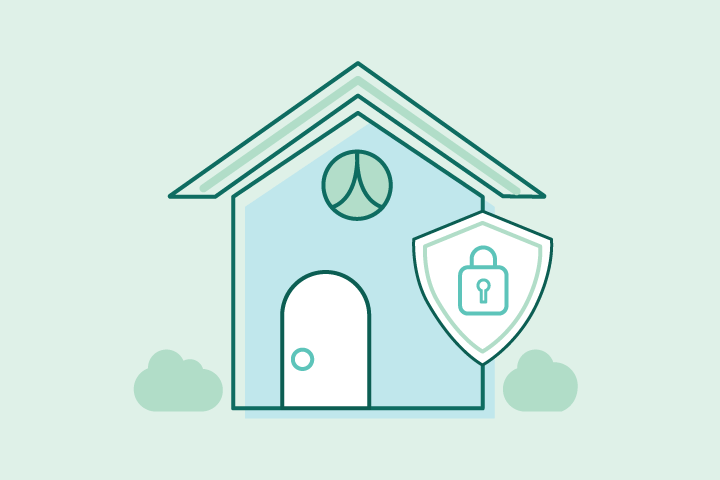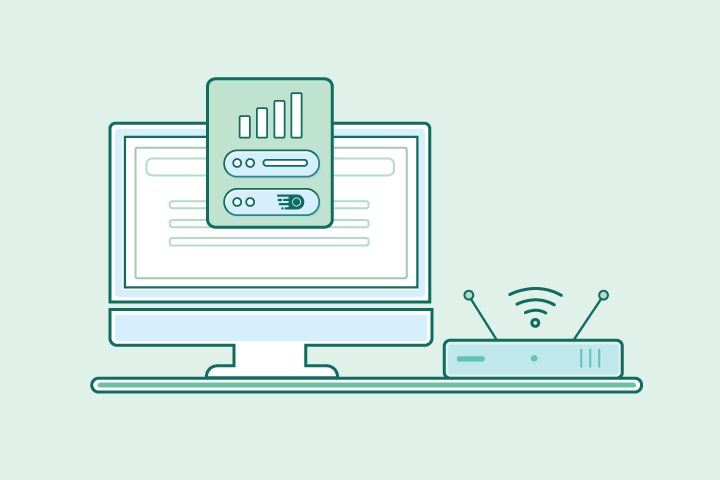Top Internet Providers for Home Security

HighSpeedOptions prides itself on providing honest, quality content. While we may be compensated when you make a purchase through links on our site, all opinions are our own. Here's how we make money.
Table of Contents
It’s no secret that you can bundle internet and TV packages, but there are a few internet service providers that also offer online and home security services. It’s not only home break-ins–cybercrime is also on the rise.
The internet providers below offer security add-ons that you can pair with their internet plans. The right provider depends on your location, budget, and how many devices you connect. Keep in mind that there are many cybersecurity tools not listed here that will protect your devices and data at home.
Key Takeaways: Internet and Home Security
- Xfinity (integrated cameras): Self Protection add-on (starting at $10/mo) supports up to 6 devices, 24/7 recording, and app control. Expect equipment purchase costs and potential post-promo price increases.
- Cox (Homelife): Self-monitored system tied to Cox-only cameras/doorbells; bundles from ~$95/mo (500 Mbps + Panoramic Wi-Fi + Homelife). No professional monitoring.
- AT&T (cybersecurity app): ActiveArmor offers call blocking, public Wi-Fi protection, and ID monitoring (starting at $3.99/mo). No professional home-security monitoring.
- HughesNet (device security): Promotes Norton 360 Deluxe trials for antivirus/identity tools. Satellite internet’s slower upload speeds and higher latency can limit multi-camera streaming.
- Upload matters most: Plan for 1–4 Mbps upload per 1080p camera (more for 2K/4K) and add 25–50% headroom. Multi-camera setups work best with speeds of at least 100 Mbps download and 20 Mbps upload.
- Cloud video = lots of data: 24/7 recording can use hundreds of GB per camera/month; event-only uses far less. Check for data caps.
- Home network tips: Choose Wi-Fi 6 (or mesh for coverage); use Ethernet for fixed cameras; keep firmware updated and passwords unique.
HughesNet
Overview of HughesNet Satellite Internet
HughesNet offers nationwide satellite internet coverage. New customers can enroll in a 2-year price lock on Gen 5 plans, which feature download speeds up to 100 Mbps and optional phone service.
Home Security Angle
HughesNet periodically promotes Norton 360 Deluxe for device-level security (parental controls, dark-web monitoring, password manager). After any free trial, Norton 360 Deluxe typically costs $5.99/month (5 devices) or $6.99/month (10 devices); availability and pricing may vary.
Pros
No hard data caps reduce risk of overage fees from camera uploads
Built-in Wi-Fi for broader in-home coverage
Cons
Low upload speeds can limit multi-camera streaming
No current deals on home security cameras
Xfinity
- Same-day installations
- 8+ million free WiFi hotspots
- Unlimited data available
Overview Of Xfinity Internet
Xfinity is the largest U.S. cable TV provider and also offers integrated home-security options. The Xfinity xFi Gateway lets you monitor network activity in the Xfinity app while you’re away. Xfinity cameras use on-device AI to flag relevant activity.
Home Security Angle
Xfinity’s Self Protection plan (from about $10/mo as an add-on) enables 24/7 recording on up to six devices and quick playback in the app or via the Xfinity Voice remote. Cameras and sensors are required and sold separately.
Pros
Check in from anywhere via the Xfinity app
Professional monitoring available
Cons
Up-front equipment costs can be steep
Prices may increase after the promo period
AT&T
Overview of AT&T Internet
AT&T offers internet, TV, and phone services nationwide, with fiber speeds up to 1,000 Mbps in select locations.
Home Security Angle
AT&T ended its professional home-security monitoring in 2022 but offers ActiveArmor, an app-based solution for call blocking, public Wi-Fi protection, identity monitoring, and data breach alerts. ActiveArmor starts around $3.99/month, with optional add-ons.
Pros
Portable, app-based security and smart-home options
No contracts required
Cons
Prices may rise after the promo period
No professional home-security monitoring
Cox
- Low introductory prices
- Excellent customer support
- Blazing fast speeds
Overview of Cox Internet
Cox offers Homelife, a self-monitored home-automation service that connects Cox video doorbells and cameras through the Panoramic Wi-Fi gateway for whole-home coverage.
Home Security Angle
Manage settings, view cameras, and get package alerts in the Cox Panoramic Wi-Fi app. Note that only Cox Homelife cameras and doorbells are compatible. Bundles start around $95/month for 500 Mbps internet, Panoramic Wi-Fi, and Homelife (equipment and availability vary).
Pros
Convenient bundling with internet and Wi-Fi
Easy self-monitoring in the Cox app
Cons
Limited to Cox-branded cameras/doorbells
No professional emergency monitoring
Internet Requirements for Home Security & Remote Monitoring
If you use services like Ring or Google Nest, your internet connection determines how smoothly you can view feeds remotely. For cameras, upload speed is the bottleneck because video is sent to your phone or the cloud.
- Plan for ~1–4 Mbps of upload per 1080p (HD) camera, more for higher resolutions (2K/4K), then add headroom for spikes and simultaneous streams.
- Pro tip: For multi-camera homes, aim for at least 100 Mbps down / 20 Mbps up. That upstream cushion keeps live views and alerts responsive.
Cloud vs. local (and data caps)
Cloud-first cameras—especially with 24/7 history—can use hundreds of gigabytes (GB) per month per camera. Event-only modes use far less (often tens of GB monthly). Given the data volume, check whether your ISP has data caps or fees.
Picking the right plan
- Count cameras × per-camera upload; add 25–50% headroom
- If you run multiple cams plus cloud backups/meetings, target ~20 Mbps upload
- Prefer Wi-Fi 6 (or Ethernet for fixed cams) and consider mesh Wi-Fi for coverage
Next Moves for a Safer, Smarter Home
Each provider approaches home security differently. Focus on upstream capacity, equipment requirements, and whether you want self-monitoring or professional monitoring. If you want an extra layer on the cybersecurity side, add a VPN (Virtual Private Network) to encrypt browsing and protect data in transit—just note that a VPN complements (not replaces) camera, router, and account-level security.
FAQs: Internet Providers and Home Security
Plan for ~1–4 Mbps of upload speed per 1080p camera (more for 2K/4K). Add 25–50% headroom so multiple cameras and motion spikes don’t choke your connection. For multi-camera homes, aim for ≥100 Mbps down / 20 Mbps up overall.
Multiply the number of cameras by the per-camera upload, then add headroom. Example: 4 cameras × 3 Mbps (1080p) = 12 Mbps; with 50% headroom ≈ 18 Mbps upload needed.
Yes—with trade-offs. Satellite’s higher internet latency and lower upload can make real-time viewing and multi-camera streaming less reliable. Event-based clips usually work better than continuous 24/7 cloud recording.
An internet and home security bundle can simplify billing and setup, and often includes app integration. Downsides include equipment lock-in, possible price hikes, and limited compatibility with third-party cameras.
Use a Wi-Fi 6 router (or mesh for larger homes), place nodes near entry points, and—if possible—wire fixed cams via Ethernet. Create a separate SSID (or VLAN if you’re advanced) for IoT/cameras, enable WPA2/WPA3, and use strong, unique passwords.
Self-monitoring sends alerts to your phone; you decide when to act. Professional monitoring can contact emergency services for you, but costs more and usually requires specific hardware/subscriptions.
Sometimes. Some providers support only their own cameras, while others work with select third-party devices. Check compatibility lists before you buy.
Look for internet service provider security tools like network-level malware and phishing filters, firewall controls, device isolation/guest networks, parental controls, and optional identity monitoring. These complement (not replace) camera and account security.
A virtual private network (VPN) protects your browsing and data-in-transit on devices. It doesn’t secure camera hardware itself, but it’s a useful layer alongside strong router settings, firmware updates, and unique passwords.
Watch for equipment fees, installation, cloud storage subscriptions, and post-promo price increases. Buying hardware upfront can reduce monthly costs; renting is easier but pricier over time.
Find providers in your area

Table of Contents








